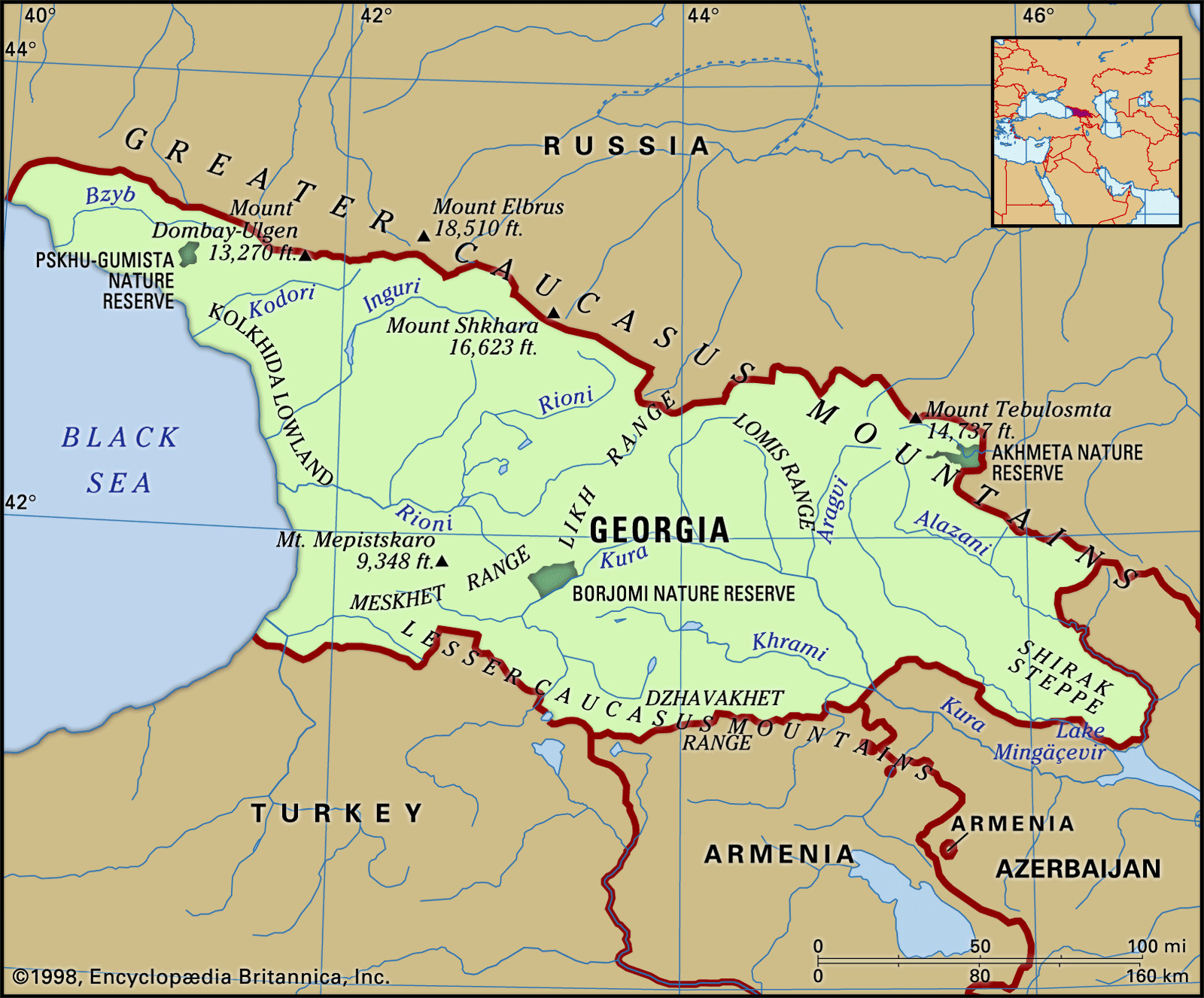Georgia, a country of remarkable geographical diversity, often prompts the question: “Where Is The Country Georgia located?”. Nestled at the crossroads of Eastern Europe and Western Asia, Georgia’s unique position shapes its varied landscapes, climate, and rich biodiversity. This article delves into the geographical features of Georgia, highlighting its location and the diverse terrains that make it such a fascinating country.
Geographical Location and Terrain
Georgia’s location is strategically significant, bordering the Black Sea to the west, Russia to the north and east, Azerbaijan to the east and southeast, and Armenia and Turkey to the south. This position in the Caucasus region, between Europe and Asia, contributes to its complex and varied geography. The terrain of Georgia is predominantly mountainous, with the Greater Caucasus Mountains in the north dominating the landscape.
The Greater Caucasus Mountains
 Physical features of Georgia, showcasing mountainous terrain and diverse landscapes
Physical features of Georgia, showcasing mountainous terrain and diverse landscapes
The northern boundary of Georgia is defined by the imposing Greater Caucasus mountain range. This formidable mountain system runs east to west and features some of the highest peaks in Europe. Mount Shkhara, Georgia’s highest point at 16,627 feet (5,068 metres), along with other peaks like Mount Rustaveli, Tetnuld, and Ushba, all contribute to the dramatic skyline. The extinct volcano Mount Mkinvari (Kazbek) also stands tall in this region. These mountains are characterized by deep gorges and numerous rivers originating from their ice-clad heights.
The Central Lowlands and Kolkhida
South of the Greater Caucasus, a band of central lowlands stretches across Georgia. The most notable part of this region is the Kolkhida Lowland, bordering the Black Sea. Historically known as Colchis, this fertile plain is formed from river deposits accumulated over millennia. Major rivers like the Inguri, Rioni, and Kodori flow from the Greater Caucasus, crossing this lowland towards the Black Sea. Once largely swampy, the Kolkhida Lowland has been transformed through drainage and afforestation projects into a prime agricultural area, particularly for subtropical crops.
The Lesser Caucasus and Southern Regions
Further south, the landscape transitions into the ranges and plateaus of the Lesser Caucasus. While not as high as the Greater Caucasus, these mountains still reach significant elevations, with Didi-Abuli peak reaching 10,830 feet. Between the Greater and Lesser Caucasus, the Meskhet and Likh ranges act as a crucial link, forming a watershed that divides the Black Sea and Caspian Sea basins. Central Georgia also features the Kartli Plain, an inner high plateau situated around the Kura River, surrounded by mountains and characterized by loess-type deposits.
Diverse Soils
Reflecting its varied geography, Georgia boasts a diversity of soil types. These range from semidesert gray-brown and saline soils to richer red earths and podzols, supporting a wide array of agricultural activities and natural vegetation.
Climate Zones of Georgia
Georgia’s climate is as diverse as its terrain, influenced by the Black Sea and the protective barrier of the Caucasus Mountains. This combination results in distinct climatic zones across the country.
Western Georgia’s Maritime Climate
Western Georgia, heavily influenced by the Black Sea, experiences a humid subtropical, maritime climate. This region is characterized by significant rainfall throughout the year, especially in autumn and winter, with annual precipitation ranging from 40 to 100 inches (1,000 to 2,500 mm). Winters are mild and warm, particularly in the coastal areas, where January temperatures rarely drop below freezing. Summers are moderately warm, averaging around 71 °F (22 °C).
Eastern Georgia’s Varied Climate
Eastern Georgia, being further inland, has a more varied climate, ranging from moderately humid to dry subtropical. Precipitation decreases as you move eastward, with plains and foothills receiving 16 to 28 inches annually, while mountainous areas receive significantly more. The southeastern parts of eastern Georgia are the driest. Summer temperatures can reach around 77 °F (25 °C) in July, while average January temperatures range from 32 to 37 °F (0 to 3 °C).
Elevation and Climate
Elevation plays a crucial role in shaping Georgia’s climate. The Kolkhida Lowland exhibits subtropical conditions up to 1,600-2,000 feet. Above this, a zone of moist, moderately warm climate prevails, followed by a belt of cold, wet winters and cool summers. Alpine conditions, with no true summer, begin above 6,600-7,200 feet, and permanent snow and ice are found above 11,200-11,500 feet.
Flora and Fauna of Georgia
Georgia’s diverse landscapes and climates foster a rich tapestry of plant and animal life, contributing to its biodiversity.
Diverse Ecosystems
The country’s location and varied terrain support a wide range of ecosystems, from subtropical coastal forests to alpine meadows and steppes. This ecological diversity is a hallmark of Georgia.
Western Georgia’s Lush Vegetation
Western Georgia is characterized by luxuriant vegetation, including relict species like Pitsunda pines. Forests are abundant, featuring oak, chestnut, beech, alder, Caucasian fir, ash, linden, and fruit trees. The underbrush is dense with evergreens like rhododendrons and holly, alongside deciduous shrubs and lianas in some forests. Citrus groves and eucalyptus trees are also common sights in this region.
Eastern Georgia’s Steppes and Mountains
Eastern Georgia has fewer forests, with steppes dotted with prickly underbrush and grasses. Higher elevations feature herbaceous subalpine and alpine vegetation.
Rich Animal Life
Georgia’s animal life is exceptionally diverse. High mountain regions are home to goats and Caucasian antelope, while rodents inhabit high meadows. The birdlife is rich, including species like mountain turkeys, Caucasian black grouse, and eagles. Rivers and lakes are abundant with trout. Forest regions are populated by wild boars, deer, brown bears, lynx, wolves, foxes, and various bird species. Lowland areas host introduced species like raccoons and mink, and both lowland rivers and the Black Sea are rich in fish.
In conclusion, when asked “Where is the country Georgia?”, the answer is a geographically strategic location in the Caucasus region, bridging Europe and Asia. This location endows Georgia with a remarkable variety of landscapes, climates, and biodiversity, making it a country of significant geographical and ecological interest.
